Basic Physics
“ The more I learn of physics, the more I drawn to metaphysics.” Albert Einstein
Introduction –
Physics is a basic discipline in the category of Natural Sciences, which also includes other disciplines like Chemistry and Biology. The word Physics comes from a Greek word meaning nature. Its Sanskrit equivalent is Bhautiki that is used to refer to the study of the physical world.
- We can broadly describe physics as a study of the basic laws of nature and their manifestation in different natural phenomena.
Branches of Physics –
Physics is a vast field with numerous branches, each focusing on specific aspects of the physical world, and majorly it divided into two – Classical and Modern Physics.
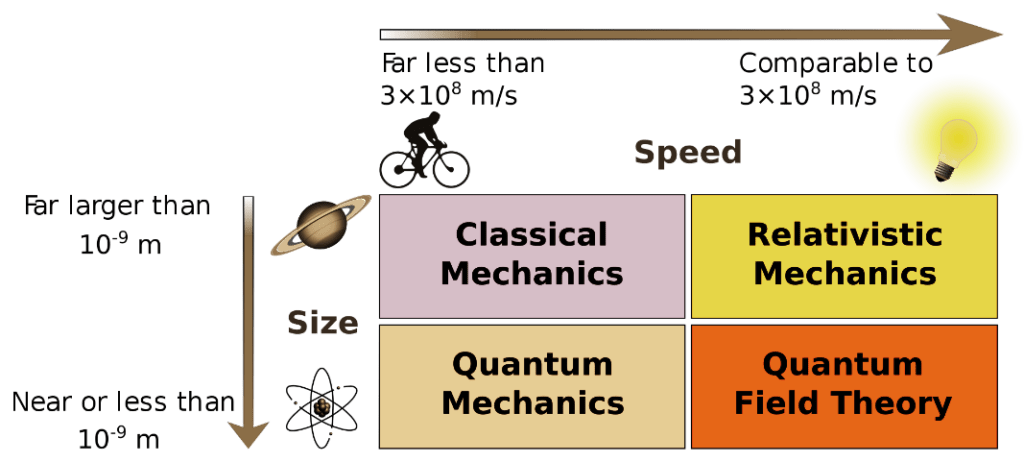
Classical Physics primarily deals with macroscopic domain which includes phenomena at the laboratory and terrestrial scales.
- Key Theories and Concepts:
- Newtonian Mechanics: Based on Sir Isaac Newton’s laws of motion, which describe the relationships between the forces acting on a body and its motion due to those forces.
- Thermodynamics: Deals with heat, work, temperature, and the statistical behavior of systems.
- Electromagnetism: Includes Maxwell’s equations, which describe the electrical and magnetic fields and their interactions.
- Classical Optics: Concerned with the behavior of visible, ultraviolet, and infrared light.
- Limitations: Classical physics accurately describes many phenomena but fails at extremely large scales (like galaxies) and very small scales (like atoms and subatomic particles). It also does not account for the extreme speeds close to the speed of light.
Modern physics is a term for theories and principles that emerged in the early 20th century and onwards, addressing the limitations of classical physics. It encompasses complex phenomena at the atomic and subatomic level and at very high velocities.
- Key Theories and Concepts:
- Quantum Mechanics: Describes physics at the atomic and subatomic levels, where particles exhibit wave-particle duality and are governed by probabilities.
- Theory of Relativity: Includes both Special and General Relativity, formulated by Einstein. Special Relativity addresses physics at speeds close to light, and General Relativity provides a new theory of gravitation.
- Quantum Field Theory: Merges quantum mechanics and special relativity. It’s the basis for understanding fundamental forces and particles.
- Cosmology: Modern cosmology often relies on general relativity to understand the universe’s origins, evolution, and large-scale structure.
- Modern physics has led to various technological advancements and a deeper understanding of the universe. It has introduced concepts like black holes, quantum computing, and the Big Bang theory.
Fundamental concepts in Physics
- Motion: – When an object moves from one place or position to another, or changes its direction, over a period of time, we say that it is in motion. Motion can be observed by comparing the object’s location or direction at different moments. Motion can also be measured by using physical quantities such as distance, displacement, speed, velocity, and acceleration.
- Distance and Displacement are two related but different concepts in physics. They both measure the motion of an object, but in different ways. Distance is the total length of the path covered by an object, regardless of its direction. Displacement is the shortest distance between the initial and final position of an object, along with its direction.
- Speed – It is one of the ways to measure the rate of motion. Mathematically, it is defined as the distance travelled by a moving object in a unit time interval. It is a scalar quantity that is to specify speed we only need magnitude. The International System of Units (SI) is meter per second. However, speed generally as calculated by above will denote average speed.
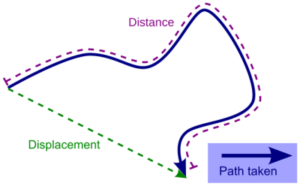 In this picture if distance and time are 100 km and 2 hours then speed would be 50Km/Hr.
In this picture if distance and time are 100 km and 2 hours then speed would be 50Km/Hr.
- Velocity – The quantity that specifies both speed and direction is termed as velocity. It is measure of both magnitude and direction and hence it is a vector quantity. It can be variable and uniform. Average velocity is calculated by dividing the displacement with total time taken in motion.

- Acceleration– If during motion velocity itself is not constant, such that either magnitude or direction changes, then the rate of change in velocity is termed as acceleration. It is again a vector quantity. It could be defined in average and instantaneous forms. The average acceleration is total change in velocity over a period of time.

Differentiate between Speed, velocity and Acceleration-
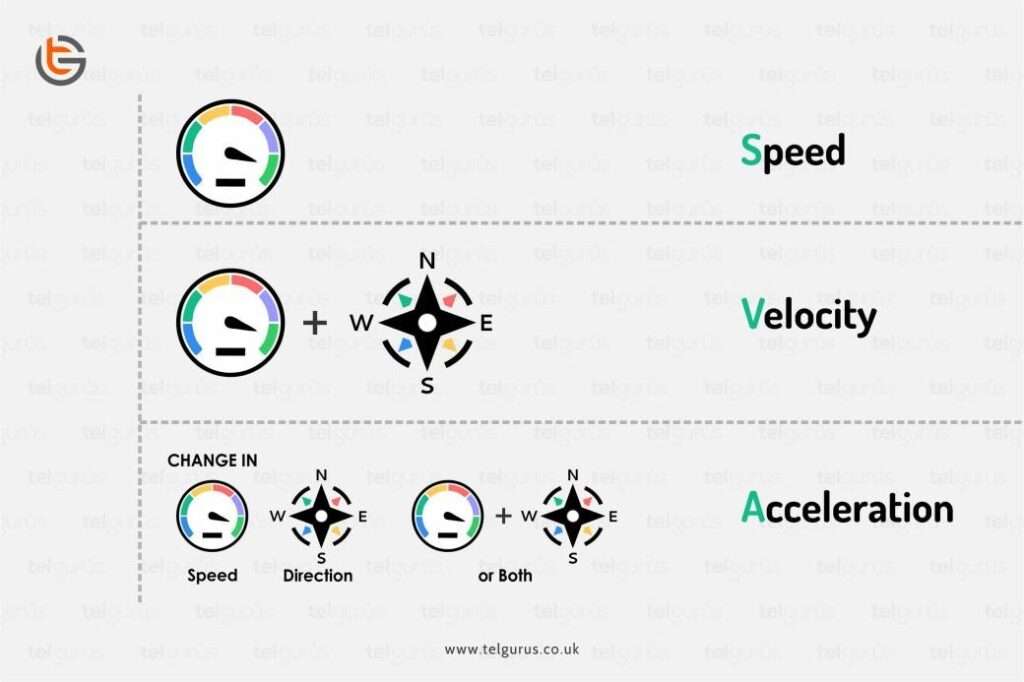
- Speed refers to how fast an object is moving, without considering direction.
- Velocity includes both the speed of an object and its direction of motion.
- Acceleration is the change in velocity, which can occur due to a change in speed, direction, or both.
Types of motion –
- On the basis of speed and acceleration of the moving object –
- Uniform motion: where the speed and direction of the object are constant, e.g., a car moving at a steady speed on a straight road.
- Non-uniform motion: where the speed and/or direction of the object change, e.g., a ball thrown in the air or a car turning a corner.
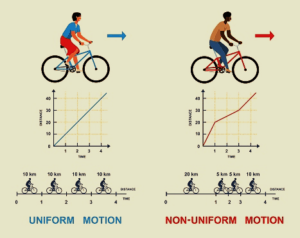
- On the basis direction and shape of the path of the moving object –
- Rectilinear motion – A objects move along a straight line. e.g., march-past of soldiers in a parade or the falling of a stone or sprinters in a 100-metre race.
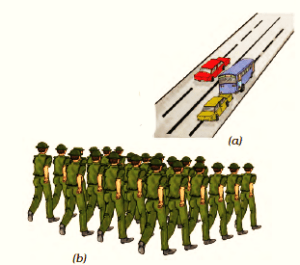
-
- Rotary motion: where an object moves around an axis. e.g., Earth rotating about its axis.

- Circular motion: where the object moves along a circular path with a constant speed but changing direction, e.g., an orbiting satellite.
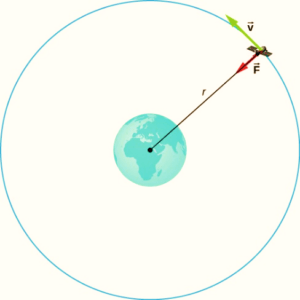
- Oscillating motion: where an object moves back and forth around a central point, e.g., Oscillation of simple pendulum

- Periodic motion: refers to the motion in which the objects repeat a path after a regular interval of time. All oscillatory motions are periodic but all periodic motions are not oscillatory.

- Projectile motion: where the object moves along a curved path under the influence of gravity, e.g., a bullet or a stone thrown horizontally.
Force and Laws of Motion
- Force is a term that is used in physics to describe the influence that causes an object to change its motion, such as speed or direction. Force can be a push or a pull, and it has both magnitude (how strong it is) and direction (which way it acts).
- Nature of Force: – All activities in day-to-day life like pushing, pulling, picking, hitting, kicking, etc., involve application of force because motion of some objects do change in all these actions.
Types of Forces: – Forces could be categorized as –
Laws of Motion: First Law of Motion –
- An object remains in a state of rest or of uniform motion in a straight line unless compelled to change that state by an applied force. It is due to inertia that hinders the change in the state of motion of an object. It is tendency of undisturbed objects to maintain their state of motion.
- g., Sudden application of Brakes makes our body to move forward. Tablecloths, if pulled quickly, can be removed from underneath of dishes. A marathoner is not able to stop himself just after crossing the finish line.
Learn From the Scientists: –
Even before Sir Issac Newton presented all three laws of motion, Galileo Galilei already made some observation about the first law.
He argued that if a marble rolls down from an inclined plane on the left side, then it would reach the exactly same height on inclined plane on right side if the inclinations on both sides are same. Finally, he deduced that objects move with a constant speed when no force acts on them.

Second Law of Motion –
- The rate of change of momentum of an object is proportional to the applied unbalanced force in the direction of force.
- The first law mentions that velocity of an object changes when an unbalanced force acts on it. The second law deals with application this of force and the acceleration produced. The mass and velocity will determine the acceleration that the object will achieve. Newton introduced one such property called Momentum to establish co-relation among them.
p= mv; and F=ma.
- g., While catching a fast-moving ball a fielder gradually pulls his hands backwards to increase the time to during which high velocity of ball decreases to zero.
Third Law of Motion –
- To every action, there is an equal and opposite reaction and they act on two different bodies. Third law states that when one object exerts a force on another object, the second object instantaneously exerts a force back on the first. These two forces are equal but opposite in in direction. These forces act on different objects and never on same object.
- g., When a gun is fired from bullet, it exerts a force on the bullet. The Bullet exerts an equal and opposite force on the gun. Since the gun has greater mass than bullet, the acceleration of the gun is much less than bullet. When a sailor jumps out of a rowing boat, the force on the boat moves it backwards.
Fundamental Forces in Nature: –
There are four fundamental forces present in Nature- Gravitational, Electromagnetic, Strong and Weak nuclear force. These forces govern how certain objects interact with each other.
Criteria for characterization of Fundamental forces-
- The type of particles that experience the force.
- The relative strength of force.
- The nature of particles that mediate the force.
- The range over which force is effective.
- Gravitational Force:
- It was discovered by Sir Isaac Newton with the hypothesis that everything in the universe that has mass attracts another object having mass. It is a central force which is only attractive in nature. It is weakest among all four forces. It is fundamental in the sense that without this force all masses will float in the universe with random collisions.
- The mechanism of operation of this force have been proposed to be through “gravitational waves/ warping of space and time” by Albert Einstein in his “Theory of General Relativity” which have been recently confirmed also.
- Examples: –
- Revolution of planets including Earth around Sun. The revolution of satellites, both natural (Moon) and artificial, around Earth is another related example.
- Tides are generated due to gravitational force.
- Daily life activities like Pouring of drinks, sliding, jumping and throwing of objects are caused due to gravity.
- Electromagnetic Force: –
- This force as given by James Clark Maxwell, is responsible for interaction between charges and their associated forces and fields. It is the combination of both electric and magnetic forces. The like charges repel while unlike charge attract each other. Only electric force is generated when charges at rest but magnetic force will also be produced when these are in motion.
- It is enormously strong compared to gravity. The electric force between two protons, for example, is 1036 times the gravitational force between them, for any fixed distance.

- Examples: –
- On rubbing a comb on the hairs, the charges get developed on the outer surface of comb.
- Cathode ray televisions make use of electromagnetic force to develop images on screen.
- Strong Nuclear Force (strong interaction): –
- This is the strongest force existing in the nature and it is responsible for holding the nucleus of an atom together. The strong nuclear force binds protons and neutrons in a nucleus. It is evident that without some attractive force, a nucleus will be unstable due to the electric repulsion between its protons.
- It acts over a range of 10-15 meter, which is the average diameter of a medium sized nucleus. It acts over a very short range, being attractive in nature. The strong nuclear force is the strongest of all fundamental forces.
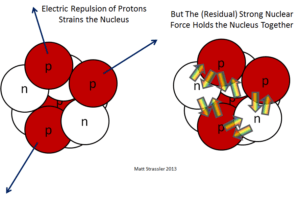
- Weak Nuclear Force (weak interaction): –
- This force is responsible for radioactive decay. Most subatomic particles are unstable and decay by weak interactions.
- The weak nuclear force is not as weak as the gravitational force, but much weaker than the strong nuclear and electromagnetic forces. The range of weak nuclear force is exceedingly small, of the order of 10-16
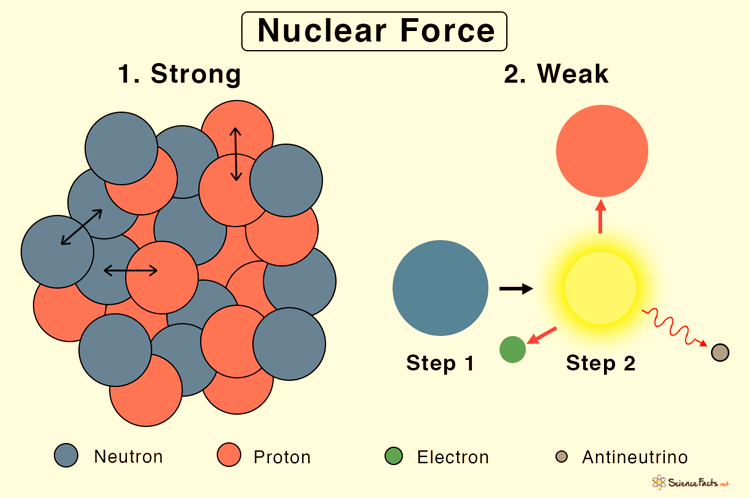
Comparison of fundamental forces: – On the basis of criteria as mentioned above, we can compare the fundamental forces-
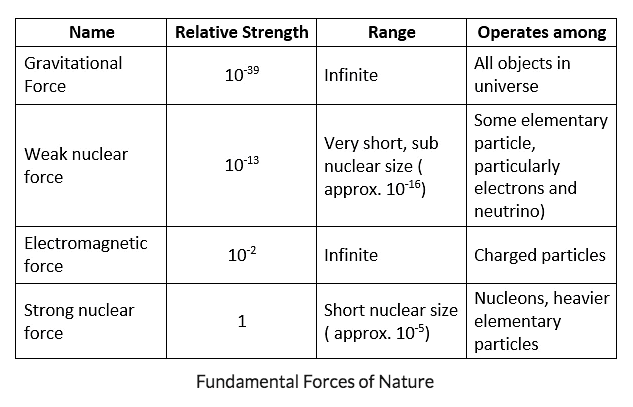
Electromagnetic waves and Spectrum –

- Waves transport energy and the pattern of disturbance has information that propagate from one point to another. Waves can be classified into different types based on their properties and how they propagate. The two main categories are mechanical waves and electromagnetic waves.
- Mechanical waves are caused by a disturbance or vibration in matter, whether solid, gas, liquid, or plasma. For e.g. – Water waves, Sound waves, seismic waves.
- In mechanical waves, If the constituents of the medium oscillate perpendicular to the direction of wave propagation, we call the wave a transverse wave (Surface ripples on water, seismic S (secondary) waves, Tsunami wave in the shallow coastal areas). If they oscillate along the direction of wave propagation, we call the wave a longitudinal wave (Tsunami waves in the deep ocean, seismic-P waves, sound waves).
- Transverse waves are possible in solids and strings (under tension) but not in fluids, because of shearing stress.
- Since longitudinal waves involve compressive stress (pressure), they can be propagated through solids and fluids.
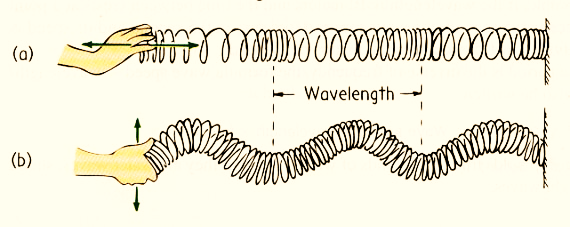
- Electromagnetic waves differ from mechanical waves in that they do not require a medium to propagate. Electromagnetic waves are invisible forms of energy that travel though the universe. This means that electromagnetic waves can travel not only through matter, but also through the vacuum of space. Examples of EM waves are radio waves, microwaves, infrared waves, light, UV rays, X-rays, gamma rays, etc.

EM Waves Classification or Spectrum
The electromagnetic (EM) spectrum encompasses the range of all types of EM radiation or waves. EM waves can be characterized or categorized based on their energy, wavelength, or frequency. Frequency is measured in cycles per second, known as Hertz. Wavelength is measured in meters. Energy is measured in electron volts.
This classification doesn’t offer a distinct division between one type of wave and the next. Therefore, understanding how they are produced or detected can provide further context to their categorization.
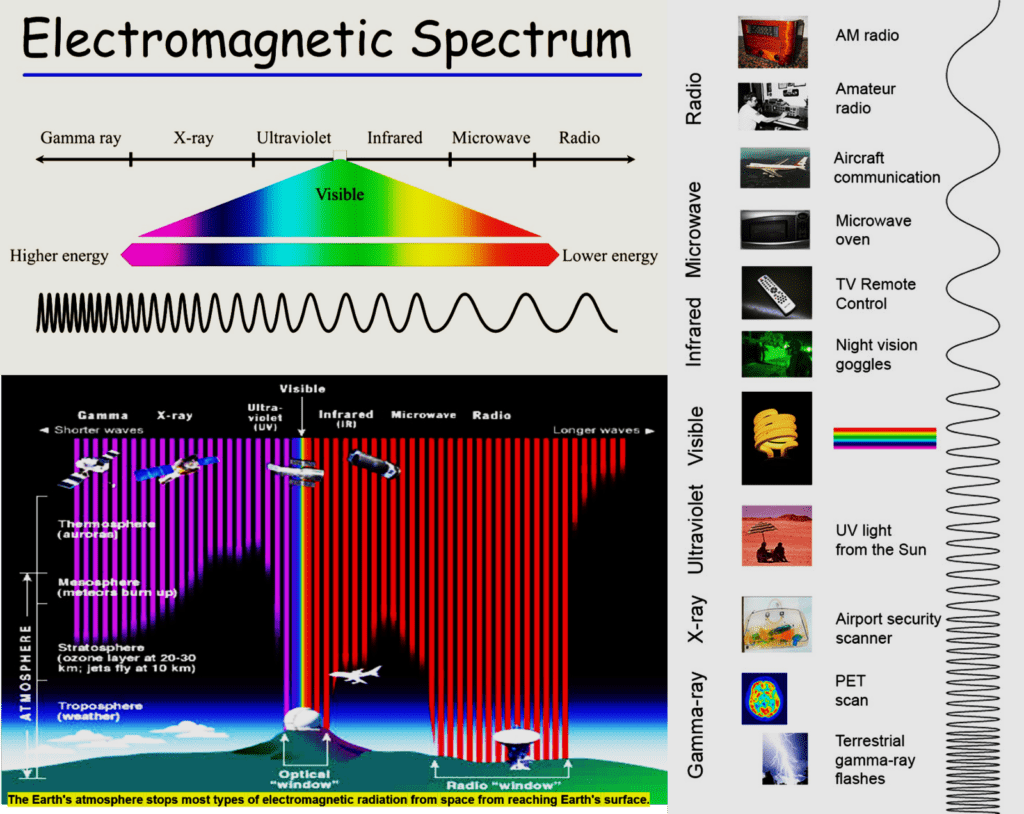
- Radio waves: – Radio waves are produced by the accelerated motion of charges in conducting wires. These waves are usually in the frequency range from 500 kHz to 1000 MHZ. A radio basically captures radio waves that are transmitted by radio stations. Radio waves can also be emitted by gases and stars in space. Radio waves are mainly used for AM, FM, TV/mobile communication.
- Microwave: Microwaves (short-wavelength radio waves), with frequencies in the gigahertz (GHz) range, are produced by special vacuum tubes (called klystrons, magnetrons and Gunn diodes). It is used by astronomers to determine and understand the structure of nearby galaxies and stars. Microwaves are short- wavelength radio waves with frequencies in the Gigahertz (GHz) range best suited for the microwave oven, mobile telephony, satellite communication, radar systems in aircraft navigation, etc.
- Infrared (heat waves): Infrared waves are produced by hot bodies and molecules. It is used widely in night vision goggles. These devices can read and capture the infrared light emitted by our skin and objects with heat. Infrared radiation also plays an important role in maintaining the earth’s warmth or average temperature through the greenhouse effect. Infrared detectors are used in Earth satellites, both for military purposes and to observe growth of crops. Electronic devices (for example semiconductor light emitting diodes) also emit infrared and are widely used in the remote switches of household electronic systems such as TV sets, video recorders and hi-fi systems.
- Visible rays: It is the most familiar form of electromagnetic waves. It is the part of the spectrum that is detected by the human eye. It runs from about 4 × 1014 Hz to about 7 × 1014 Hz or a wavelength range of about 700 – 400 nm. Visible light emitted or reflected from objects around us provides us information about the world. Our eyes are sensitive to this range of wavelengths.
- Ultraviolet: Ultraviolet (UV) radiation is produced by special lamps and very hot bodies. The sun is an important source of ultraviolet light. But fortunately, most of it is absorbed in the ozone layer in the atmosphere at an altitude of about 40 – 50 km. UV light in large quantities has harmful effects on humans.
- Ultraviolet light has many applications in various fields, such as: Tanning, Fluorescent inspection, Disinfection, Water sanitization, Air cleaning, Indoor gardening and others.
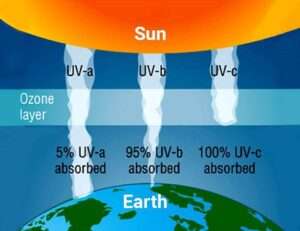
- X-ray: X-rays are also given out by hot gases in the universe. In the electromagnetic spectrum, X-rays lie beyond the ultraviolet region. One common way to generate X-rays is to bombard a metal target by high energy electrons. X-rays can be used in many instances. X-rays are used as a diagnostic tool in medicine and as a treatment for certain forms of cancer. Because X-rays damage or destroy living tissues and organisms, care must be taken to avoid unnecessary or over exposure.
- Gamma-ray: They lie in the upper frequency range of the electromagnetic spectrum and have wavelengths. Interestingly, the universe is the biggest gamma-ray generator of all. This high frequency radiation is produced in nuclear reactions and also emitted by radioactive nuclei. It has a wide application in the medical field. They are used in medicine to destroy cancer cells.
Note: Stars and other hot objects in the universe emit radiation in wavelengths formed throughout the electromagnetic spectrum, including radio waves and microwaves.
Basics of Light and Optics
Nature has endowed the human eye (retina) with the sensitivity to detect electromagnetic waves within a small range of the electromagnetic spectrum. Electromagnetic radiation belonging to this region of the spectrum (wavelength of about 400 nm to 750 nm) is called light or Visible Radiation.
As a branch of physics, optics studies the behaviour and properties of light, including its interactions with matter.
Light and its Properties-
- Light is a form of energy and it is propagated in the form of Electromagnetic waves.
- Light travels at a speed of approximately 3*10^8 meters per second in a vacuum. This speed is commonly referred to as c and is a fundamental constant in physics. The speed can vary slightly when light travels through different media, such as air, water, or glass.
- Light can behave as-
- Ray – In ray optics, light is treated as traveling in straight lines, called rays. Used to explain phenomena of Reflection, Total internal Reflection, Refraction Dispersion and Scattering.
- Wave – Wave optics considers light as an electromagnetic wave, characterized by its wavelength and frequency. Used to explain phenomena such as interference, and diffraction.
- Particle – In quantum theory, light is thought of as being composed of particles called photons. Used to explain quantum phenomena like Photoelectric effect.
Interaction of Light with Matter –
When light interacts with matter following phenomena could be observed-
- Reflection of Light– When light moving in a certain medium, falls at surface of another medium, part of it returns back to the same medium. Thus, phenomenon of light returning back to same medium after falling at interface of two media is known as reflection.
Laws of reflection: –
- The angle of incidence is equal to angle of reflection. Ɵi = Ɵr
- The incident ray, the normal to the surface at point of incidence and the reflected ray, all lie in the same plane.
- These laws of reflection are applicable to all types of reflecting surfaces.
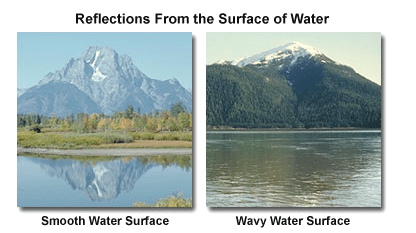
- Examples-
- The simplest example of visible light reflection is the surface of a smooth pool of water, where incident light is reflected in an orderly manner to produce a clear image of the scenery surrounding the pool.
- Objects seen in mirrors (plane and spherical mirrors) due to reflection of light.
- Glowing of stars, Lightning of moon in night, Reflection from luminous objects.
- Refraction of Light- When light travels from one medium into another, the light waves may undergo a phenomenon known as refraction, which is manifested by a bending or change in direction of the light. Refraction occurs as light passes from one medium to another only when there is a difference in the index of refraction between the two materials. When a light enters from a rarer to denser medium it deviates towards the normal drawn on the boundary of the two media at the incident medium. Similarly, in passing from denser to rarer medium, light deviates away from normal. Also, if light is incident normally on the boundary, it enters second medium without deviation.
- If c is the speed of light in air and v is the speed of light in the medium, then, the refractive index (n) of the medium nm is given by – n=c/v, for example, the refractive index of water is about 1.33, which means light travels about 1.33 times slower in water than in a vacuum. Similarly, the refractive index of air is approximately 1.0003, which is very close to the speed of light in a vacuum, indicating that light travels almost as fast in air as it does in a vacuum.

The Law of Refraction / Snell’s Law –
- It describes how light bends, or refracts, when it passes from one medium into another. The law is based on the relationship between the angle of incidence and the angle of refraction, as well as the refractive indices of the two media. The formula for Snell’s Law is: n1 sinθi =n2 sinθr
- n1 is the refractive index of the first medium (from which the light is coming)
- θi is the angle of incidence (the angle between the incident ray and the normal to the surface at the point of incidence).
- n2 is the refractive index of the second medium (into which the light is entering).
- θr is the angle of refraction (the angle between the refracted ray and the normal).
- The angles are measured with respect to the normal to the boundary between the two media.
- If n2 > n1, the refracted ray bends towards the normal; if n2 < n1, it bends away from the normal.
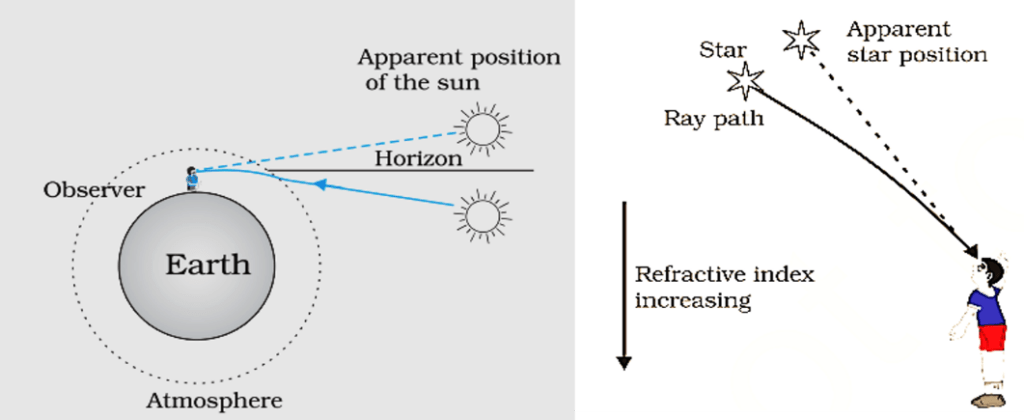
- Examples-
- The refraction of visible light is also an important characteristic of lenses that enables them to focus a beam of light onto a single point.
- Twinkling of Stars– light from stars is refracted in different directions because of turbulence in the atmosphere of the earth, this causes star’s image to change slightly in brightness and position and hence twinkling.
- Advance sunrise and delayed sunset – The sun is visible a little before the actual sunrise and until a little after the actual sunset due to refraction of light through the atmosphere. The apparent flattening (oval shape) of the sun at sunset and sunrise is also due to the same phenomenon.
- Total Internal Reflection – When light travels from an optically denser medium to a rarer medium at the interface, it is partly reflected back into the same medium and partly refracted to the second medium. This reflection is called the internal reflection.
- As the angle of incidence increases, so does the angle of refraction. and at critical incident angle, the refracted ray is bent so much away from the normal that it grazes the surface at the interface between the two media. If the angle of incidence is increased still further refraction is not possible, and the incident ray is totally reflected. This is called total internal reflection.
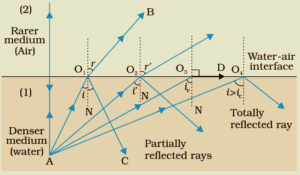
- Total Internal Reflection (TIR) is an important principle in optics and has practical applications in various technologies:
- Fiber Optic Cables and long-distance communication: TIR is used in fiber optics to transmit light signals over long distances with minimal loss.
- Optical Instruments: Some optical instruments, like binoculars and periscopes, use prisms that utilize TIR to change the direction of light.
- Mirages: Natural phenomena like mirages are caused by total internal reflection in layers of air with different temperatures and, consequently, different refractive indices.
- Sparkling of diamond and in Prism.
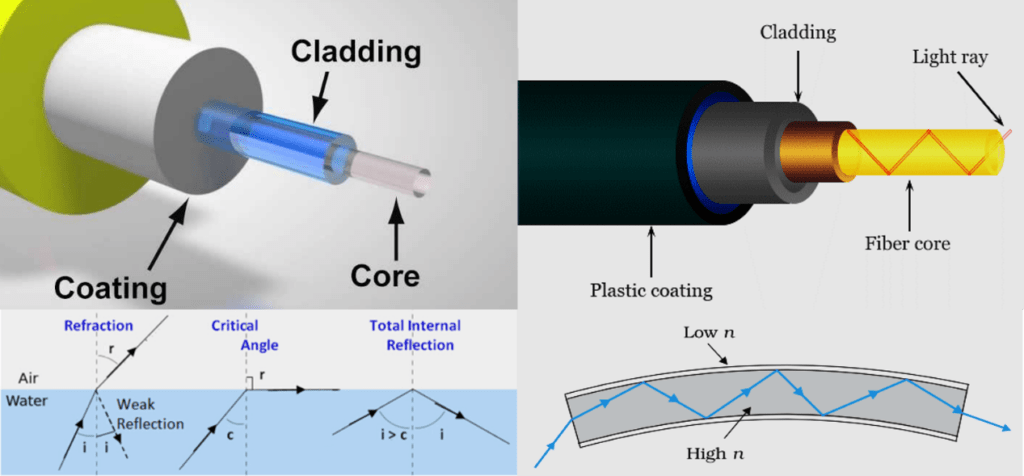
- Scattering of Light – It is the phenomenon in which light rays get diffused or deviated from its straight path on striking an obstacle like dust or gas molecules, water vapours etc. When sunlight enters the atmosphere of the earth, the atoms and molecules of different gasses present in the air absorb the light. Then these atoms re-emit light in all directions. This process is known as Scattering of light. The atoms or particles that scatter light are called scatterers. Scattering of light gives rise to many spectacular phenomena such as Tyndall effect and the “red hues of sunrise and sunset”.
- Examples:
- Atmospheric Effects: Blue sky and red sunrise and sunsets due to Rayleigh scattering.
- Medical and Biological Imaging: Using scattering properties to image cells and tissues.
- Astronomical Observations: Analyzing light from stars and galaxies, where scattering by interstellar dust can affect observations.
- Tyndall Effect
- Tyndall effect is the phenomenon of scattering of light by colloidal particles (suspended small particles in colloidal solution).
- Examples – When a beam of sunlight enters the dark room through small hole or window then its path become visible due to scattering of light by the dust particles present in the room or when a beam of light is projected on a screen from a projector in the cinema hall, it becomes visible or when sunlight passes through the canopy of a dense forest it get scattered by tiny water droplets.

- Dispersion of Light – It refers to the splitting of white light into its constituent colours (spectrum) when it passes through a medium like a prism. This happens because different wavelengths (colours) of light refract (bend) by different amounts when passing through a medium, because refractive index of most materials varies with the wavelength of light.
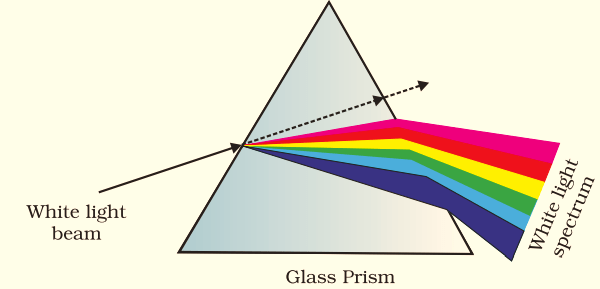
- Example –
- The rainbow is an example of the dispersion of sunlight by the water drops in the atmosphere. This is a phenomenon due to combined effect of dispersion, refraction and internal reflection of sunlight by spherical water droplets of rain. The conditions for observing a rainbow are that the sun should be shining in one part of the sky (say near western horizon) while it is raining in the opposite part of the sky (say eastern horizon). An observer can therefore see a rainbow only when his back is towards the sun.
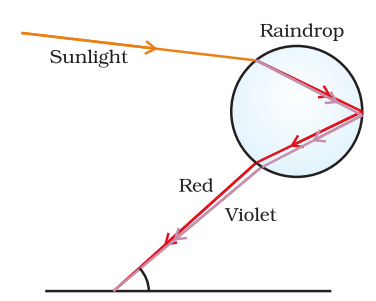
- Interference of Light – The interference of light is a phenomenon that occurs when two or more light waves overlap and combine with each other. This effect is a direct consequence of the wave nature of light, as described by wave optics.
- Constructive Interference: This occurs when the crests of two light waves align together (or troughs align together), resulting in an increase in the intensity of light at that point. Brighter Light at that point.
- Destructive Interference: This happens when the crest of one wave aligns with the trough of another, causing the waves to cancel each other out. darkness at that point.
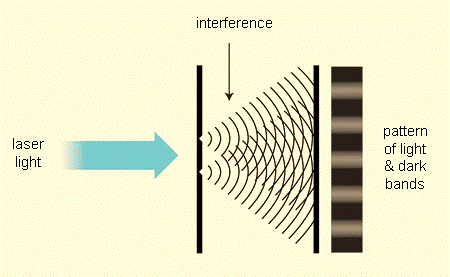
- Diffraction of Light – It is a phenomenon that occurs when a wavefront of light encounters an obstacle or a slit that is comparable in size to its wavelength. This causes the light to bend around the edges of the obstacle or through the slit, spreading out rather than traveling in a straight line.
- Example –
- Compact Discs (CDs) and Digital Versatile Discs (DVDs) both exhibit diffraction of light.
- The diffraction of sunlight by clouds is often called a silver lining.
- Single slit and Double slit
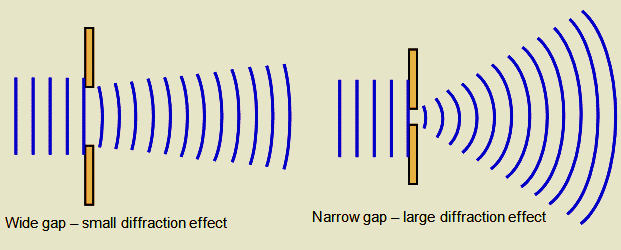
- Photoelectric effect – The photoelectric effect is a phenomenon in physics where electrons are emitted from a material’s surface when it is exposed to light. This effect is significant in the field of quantum mechanics and was crucial in understanding the particle nature of light.
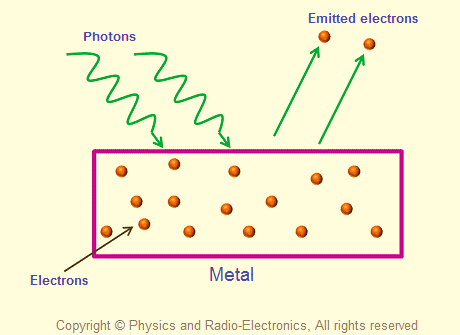
PYQs –
- The technique used to transmit audio signals in television broadcasts is : [1995]
(a) Amplitude Modulation
(b) Frequency Modulation
(c) Pulse Code Modulation
(d) Time Division Multiplexing
- Who among the following anticipated Newton by declaring that all things gravitate to the earth? [1995]
- a) Aryabhatta
- b) Varahamihira
- c) Buddhagupta
- d) Brahmagupta
- The variation of displacement d with time t in the case of a particle falling freely under gravity from rest is correctly shown in the graph: [1996]
- Which of the following types is used by computed tomography employed for visualisation of the internal structure of human body? [2007]
- X-ray (b) South waves (c) Magnetic resonance (d) Radio isotopes
- Which one of the following types of waves are used in a night vision apparatus? [2009]
(a) Radio waves (b) Microwaves
(c) Infra-red waves (d) None of the above
- Electrically charged particles from space travelling at speeds of several hundred km/sec can severely harm living beings if they reach the surface of the Earth. What prevents them from reaching the surface of the Earth? [2012]
(a) The Earth’s magnetic field diverts them towards its poles
(b) Ozone layer around the Earth reflects them back to outer space
(c) Moisture in the upper layers of atmosphere prevents them from reaching the surface of the Earth
(d) None of the statements (a), (b) and (c) given above is correct
- The known forces of nature can be divided into four classes, viz., gravity, electromagnetism, weak nuclear force and strong nuclear force. With reference to them, which one of the following statements is not correct? [2013]
(a) Gravity is the strongest of the four
(b) Electromagnetism acts only on particles with an electric charge
(c) Weak nuclear force causes radioactivity
(d) Strong nuclear force holds protons and neutrons inside the nucleus of an atom
- Ball bearings are used in bicycles, cars, etc., because [2013]
(a) the actual area of contact between the wheel and axle is increased
(b) the effective area of contact between the wheel and axle is increased
(c) the effective area of contact between the wheel and axle is reduced
(d) None of the above statements is correct
- In a pressure cooker, the temperature at which the food is cooked depends mainly upon which of the following? 2021
Area of the hole in the lid
2. Temperature of the flame
3. Weight of the lid
Select the correct answer using the code given below.
(a) 1 and 2 only
(b) 2 and 3 only
(c) 1 and 3 only
(d) 1,2 and 3
- Consider the following actions:
- Detection of car crash/collision which results in the deployment of airbags almost instantaneously.
- Detection of accidental free fall of a laptop towards the ground which results in the immediate turning off of the hard drive.
- Detection of the tilt of the smartphone which results in the rotation of display between portrait and landscape mode.
In how many of the above actions is the function of an accelerometer required?
(a) Only one
(b) Only two
(c) All three
(d) None
- Optical fibre works on the principle of: [1995]
(a) Total internal reflection
(b) Refraction
(c) Scattering
(d) Interference
- Assertion (A): A diamond sparkles more than a glass imitation cut to the same shape.
Reason (R): The refractive index of diamond is less than that of glass.
In the context of the above two statements, which one of the following is correct? [1995]
(a) Both A and R are true, and R is the correct explanation of A
(b) Both A and R are true, but R is not a correct explanation of A
(c) A is true, but R is false
(d) A is false, but R is true
- Total internal reflection can take place when light travels from: [1996]
(a) Diamond to glass
(b) Water to glass
(c) Air to water
(d) Air to glass
- Consider the following statements: [1999]
- If a person looks at a coin which is in a bucket of water, the coin will appear to be closer than it really is.
- If a person underwater looks at a coin above the water surface, the coin will appear to be at a higher level than it really is.
Which of the above statements is/are correct?
(a) 1 and 2
(b) 1 alone
(c) 2 alone
(d) Neither 1 nor 2
- Assertion (A): Small glass beads fixed on traffic signals glow brightly when light falls upon them.
Reason (R): Light is totally reflected when the angle of incidence exceeds a certain critical value, and light traveling in a denser medium is reflected from a rarer medium. [2000]
Codes:
(a) Both A and R are true, and R is the correct explanation of A
(b) Both A and R are true, but R is not a correct explanation of A
(c) A is true, but R is false
(d) A is false, but R is true
- When a CD (compact disc used in audio and video systems) is seen in sunlight, rainbow-like colours are seen. This can be explained on the basis of the phenomenon of: [2000]
(a) Reflection and diffraction
(b) Reflection and transmission
(c) Diffraction and transmission
(d) Refraction, diffraction, and transmission
- Consider the following phenomena: [2013]
- Size of the sun at dusk
- Color of the sun at dawn
- Moon being visible at dawn
- Twinkle of stars in the sky
- Polestar being visible in the sky
Which of the above are optical illusions?
(a) 1, 2, and 3
(b) 3, 4, and 5
(c) 1, 2, and 4
(d) 2, 3, and 5
- Rainbow is produced when sunlight falls on drops of rain. Which of the following physical phenomena are responsible for this? [2013]
- Dispersion
- Refraction
- Internal reflection
Select the correct answer using the codes below:
(a) 1 and 2 only
(b) 2 and 3 only
(c) 1 and 3 only
(d) 1, 2, and 3
- Diffusion of light in the atmosphere takes place due to: [2003]
(a) Carbon dioxide
(b) Dust particles
(c) Helium
(d) Water vapours
- Consider the following natural phenomena: [2002]
- Terrestrial heating
- Reflection of light
- Refraction of light
- Diffraction of light
Due to which of these phenomena is a mirage formed?
(a) 1 and 2
(b) 2, 3, and 4
(c) 2 and 3
(d) 4 only
- When light waves pass from air to glass, the variables affected are: [2001]
(a) Wavelength, frequency, and velocity
(b) Velocity and frequency
(c) Wavelength and frequency
(d) Wavelength and velocity
- Consider the following statements: UPSC 2023
- In a seismograph, P waves are recorded earlier than S waves.
- In P waves, the individual particles vibrate to and fro in the direction of wave propagation whereas in S waves, the particles vibrate up and down at right angles to the direction of wave propagation.
Which of the statements given above is/are correct?
- a) 1 only
- b) 2 only
- c) Both 1 and 2
- d) Neither 1 nor 2
- With reference to the Earth’s atmosphere, which one of the following statements is correct? UPSC 2023
- a) The total amount of insolation received at the equator is roughly about 10 times of that received at the poles.
- b) Infrared rays constitute roughly two-thirds of insolation.
- c) Infrared waves are largely absorbed by water vapour that is concentrated in the lower atmosphere.
- d) Infrared waves are a part of visible spectrum of electromagnetic waves of solar radiation.
- Consider the following statements:
Statement-I: The atmosphere is heated more by incoming solar radiation than by terrestrial radiation.
Statement-II: Carbon dioxide and other greenhouse gases in the atmosphere are good absorbers of long wave radiation.
Which one of the following is correct in respect of the above statements?
- Both Statement-I and Statement-II are correct and Statement-II explains Statement-I
(b) Both Statement-I and Statement-II are correct, but Statement-II does not explain Statement-I
(c) Statement-I is correct, but Statement-II is incorrect
(d) Statement-I is incorrect, but Statement-II is correct
- What is the role of ultraviolet (UV) radiation in the water purification systems? 2012
- It inactivates/kills the harmful microorganisms in water.
- It removes all the undesirable odours from the water.
- It quickens the sedimentation of solid particles, removes turbidity and improves the clarity of water.
Which of the statements given above is/are correct?
- A) 1 only
- B) 2 and 3 only
- C) 1 and 3 only
- D) 1, 2 and 3
- The increasing amount of carbon dioxide in the air is slowly raising the temperature of the atmosphere, because it absorbs – 2012
- the water vapour of the air and retains its heat
- the ultraviolet part of the solar radiation
- all the solar radiations
- the infrared part of the solar radiation
- Recently, LASIK (Laser Assisted In Situ Keratomileusis) procedure is being made popular for vision correction. Which one of the following statements in this context is not correct?
(a) LASIK procedure is used to correct refractive errors of the eye
(b) It is a procedure that permanently changes the shape of the cornea
(c) It reduces a person’s dependence on glasses or contact lenses
(d) It is a procedure that can be done on a person of any age
- What is the principle by which a cooling system (Radiator) in a motor car works? 2010
(a) Conduction only
(b) Convection
(c) Radiation only
(d) Both conduction and radiation
- If a potato is placed on a pure paper plate which is white and unprinted and put in a microwave oven, the potato heats up but the paper plate does not. This is because: 2010
(a) Potato is mainly made up of starch whereas paper is mainly made up of cellulose
(b) Potato transmits microwaves whereas paper reflects microwaves
(c) Potato contains water whereas paper does not contain water
(d) Potato is a fresh organic material whereas paper is a dead organic material
- Which one among the following has the highest energy? 2009
(a) Blue light
(b) Green light
(c) Red light
(d) Yellow light
| QUESTION | 1 | 2 | 3 | 4 | 5 | 6 | 7 | 8 | 9 | 10 | 11 | 12 | 13 | 14 | 15 | 16 | 17 | 18 | 19 | 20 | 21 | 22 | 23 | 24 | 25 | 26 | 27 | 28 | 29 | 30 |
| ANSWER | B | D | A | A | C | A | A | C | C | C | A | C | A | C | A | D | C | D | B | C | D | C | C | D | A | D | D | B | C | A |
